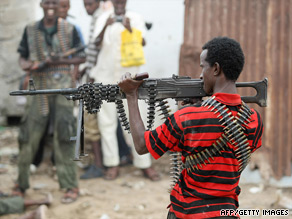
Amid the worsening conflict in his country, Somalia’s president made a plea for Somalis living in the United States to stop sending their young men to fight.
“I call on the Somali-American community not to send their youth to Somalia to fight alongside al-Shabaab,” President Sheik Sharif Ahmed said on Sunday. He was referring to the Islamist militant group that is waging a brutal war against his administration in Mogadishu. “I am saying to those young men from abroad: ‘Your families fled your home to America because of insecurity. You should not return here to ferment violence against your people,'” he said. Somalis began arriving in the United States in significant numbers after the U.S. intervention in Somalia’s humanitarian crisis in 1992. A sizable group of young Somali-American men left Minneapolis last year and were feared recruited by al-Shabaab militants. In October, Shirwa Ahmed, 27, a Somali-American who had been radicalized by al-Shabaab in his adopted home state of Minnesota, traveled to Somalia and blew up himself and 29 others. The incident — the first-ever suicide bombing by a naturalized U.S. citizen — raised red flags throughout the U.S. intelligence community. The president’s call came after fresh fighting erupted Sunday between Somalia’s transitional government forces and Islamist rebels. According to several witness accounts, AMISOM — the African Union Mission to Somalia — supported government forces to push back al-Shabaab as the militia attacked the presidential palace. AMISOM tanks and soldiers were involved in the fighting, according to witnesses. “The sound of heavy artillery in Mogadishu was very loud and continuous,” a witness told CNN. “It was shaking the ground, and many buildings were destroyed by the shelling.”
Don’t Miss
Obama: War a millstone around Africa’s neck
U.N.: Fighting in Somalia’s capital sparks massive refugee exodus
Kenya rejects call for military help in Somalia
The president called the operation “a clear victory” against al-Shabaab. “Our forces have weakened the strength of the al-Shabaab militia in this fighting,” Ahmed said. Government forces displayed the bodies of five al-Shabaab fighters in their trademark green uniforms. Al-Shabaab, a group that is on the U.S. government’s terror watch list, remains entrenched in the northeast and sections of the south of the capital. The group categorized the involvement of AMISOM as a shift in their attempts to overthrow the transitional government. “The fighting in Mogadishu has entered a new phase. Now it’s between us and AMISOM,” said Ali Mohamud Rage, a spokesman for al-Shabaab. “AMISOM was backing up the government directly, but we will keep fighting.” Somalia has been mired in chaos since 1991, when warlords overthrew dictator Mohamed Siad Barre and sparked brutal clan infighting. The transitional government has struggled to establish authority, challenged by Islamist groups that have seized control of Mogadishu and much of the south. The United Nations estimates that more than 200,000 people have been forced to flee Mogadishu since the latest round of fighting began in early May between the government and the Al-Shabaab and Hisb-ul-Islam groups. The Somali-American population in the United States is concentrated in clusters primarily in Minneapolis; Columbus, Ohio; Seattle, Washington; and San Diego, California. The potential recruitment of young Somali-American men has been made possible by “a number of factors that come together when a dynamic, influential and extremist leader gains access to a despondent and disenfranchised group of young men,” Andrew Liepman, deputy director for intelligence at the National Counterterrorism Center, said earlier this year. Many refugees, he said, “lack structure and definition in their lives” and are “torn between their parents’ traditional tribal and clan identities, and the new cultures and traditions offered by American society.”